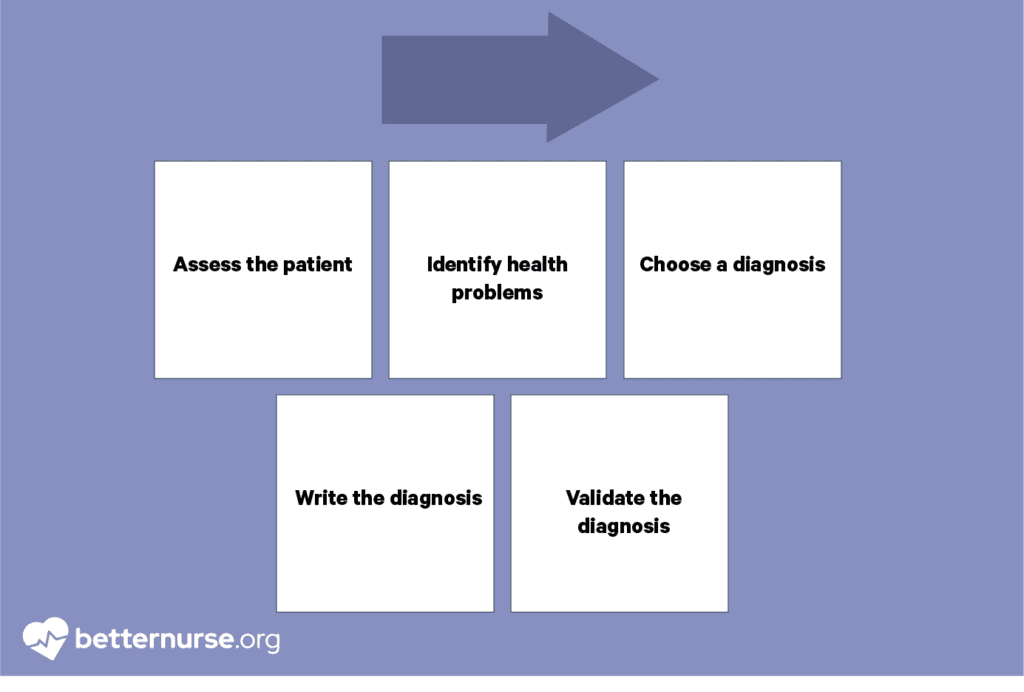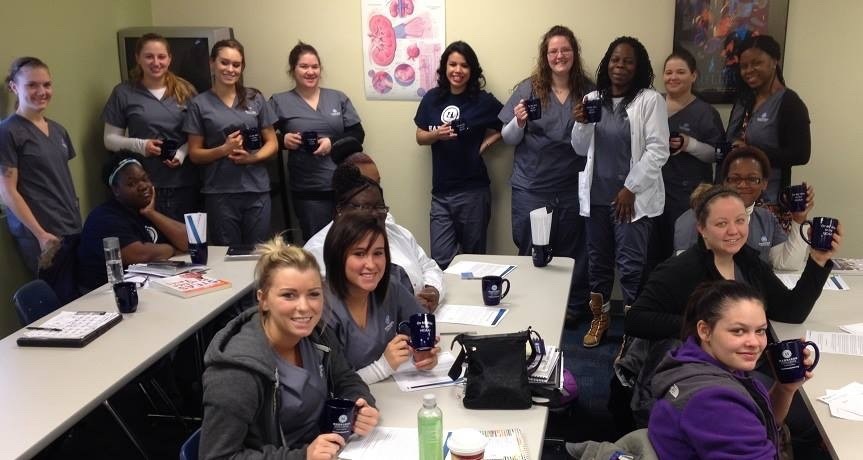A nursing diagnosis is a systematic method utilized by nurses to collect and analyze clinical-assessment data, which then informs the development of a tailored care plan to address the unique health needs and challenges faced by individual patients.
As a nursing student or a registered nurse, you might have come across the term “nursing diagnosis.” But what exactly does it mean, and why is it important?
Well, diagnosis is an essential part of nursing that helps nurses provide adequate patient care. To fully comprehend the process, its purpose, and how to write a nursing diagnosis, you must know its three main components and the classifications made by The North American Nursing Diagnosis Association.
Table of contents
- Takeaway
- What Is Nursing Diagnosis?
- What Is the Purpose of Nursing Diagnosis?
- Examples of Nursing Diagnoses
- Nursing Diagnosis vs. Medical Diagnosis vs. Collaborative Problems
- NANDA Diagnosis
- Classification of Nursing Diagnoses
- The 5 Types of Nursing Diagnoses
- The 3 Main Components of a Nursing Diagnosis
- How To Write a Nursing Diagnosis
- Conclusion
Takeaway
Much like a roadmap, nursing diagnosis helps nurses navigate their patient’s health status as well as identify potential health problems. Its primary purpose is to guide nurses and other healthcare professionals on the best routes to follow while taking into account relevant factors related to their patient’s conditions. Like a map, the nursing diagnosis helps people reach their desired destination—good health.
What Is Nursing Diagnosis?
Nursing diagnosis refers to a clinical judgment made by a nurse to identify their patient’s potential or actual health problems that can be managed independently by the nurse or collaboratively with other healthcare professionals. It provides the basis for selecting nursing interventions to achieve outcomes for which the nurse is accountable.
What Is the Purpose of Nursing Diagnosis?
The primary purpose of a nursing diagnosis is to provide a framework for nurses to identify and prioritize patients’ health problems and address potential health concerns based on the data collected during the nursing assessment. So, nurse diagnosis guides the development of nursing care plans and interventions tailored to the patient’s needs.
Nursing diagnosis also serves as a channel for enhancing communication among healthcare professionals. The diagnosis helps share relevant data about the patient’s needs and potential problems with other healthcare personnel, including physicians, therapists, and social workers, through clear descriptions of the patient’s condition, interventions, and predicted results.
Examples of Nursing Diagnoses
Based on the symptoms that the patient shows, nurses can conclude various nursing diagnoses, such as:
- Risk for Infection: A nurse may write such a diagnosis for a patient at risk of developing an infection due to a compromised immune system, surgical incisions, or indwelling catheters.
- Impaired Skin Integrity: A nurse may write such a diagnosis for a patient with an altered epidermis due to accidents, immobility, pressure ulcers, or surgical incisions.
- Impaired Mobility: A nurse may write such a diagnosis for a patient struggling with movement or activity due to an injury, stiffness, or chronic conditions such as arthritis.
Nursing Diagnosis vs. Medical Diagnosis vs. Collaborative Problems
Though they sound similar, nursing diagnosis, medical diagnosis, and collaborative problems differ in focus and scope.
A nursing diagnosis is a clinical judgment made by a nurse in contrast to a medical diagnosis generally made by a physician. Then, nursing diagnoses identify concerns based on the data gathered during the initial assessment. So, they focus on the patient’s response rather than the disease or medical condition.
On the other hand, medical diagnoses are based on results from medical tests and physical examinations. Thus, they serve to identify a specific disease or condition. Collaborative problems combine the two by involving nursing and medical diagnoses related to the patient’s medical condition and are a joint effort between various healthcare team members.
Lastly, nursing diagnoses help develop an individualized patient care plan, whereas medical diagnoses guide the medical treatment process, and collaborative problems integrate both practices.
NANDA Diagnosis
The North American Nursing Diagnosis Association (NANDA) developed a standardized nursing diagnosis system that provides a framework for identifying, categorizing, and addressing patients’ health problems. The NANDA diagnosis involves several diagnosis types based on examination, analysis, and interpretation of patient data. Ultimately, it aims to ensure consistent nursing care across different healthcare settings.
Classification of Nursing Diagnoses
Various classification systems may be used to categorize nursing diagnoses, such as the Clinical Care Classification (CCC) system or the International Classification for Nursing Practice (ICNP). However, one of the most widely used systems is the NANDA-I Taxonomy II.
According to the latest NANDA-I 2021-2023 edition, nursing diagnoses are organized and categorized based on their characteristics and related factors. This taxonomy consists of three levels.
Level 1: Domains
This taxonomy includes 13 domains to categorize nursing diagnoses based on the patient’s health status or problem. These domains include:
- Health Promotion
- Nutrition
- Elimination and Exchange
- Activity/Rest
- Perception/Cognition
- Self-Perception
- Role Relationships
- Sexuality
- Coping/Stress Tolerance
- Life Principles
- Safety/Protection
- Comfort
- Growth/Development
Level 2: Classes
Each domain contains several classes that further categorize nursing diagnoses. For example, the Perception/Cognition domain contains classes such as:
- Attention
- Orientation
- Sensation/Perception
- Cognition
- Communication
Level 3: Nursing diagnoses
This is the most specific level, where the actual nursing diagnoses are listed. Each nursing diagnosis is labeled with a unique code and includes a definition, related factors, and defining characteristics.
The 5 Types of Nursing Diagnoses
Generally, there are five types of nursing diagnoses. They differ based on the focus and purpose.
1. Problem-focused diagnosis
This type of nursing diagnosis focuses on a specific health problem that the patient is experiencing. Examples include:
- Impaired physical mobility related to a recent stroke
- Ineffective breathing pattern related to asthma exacerbation
2. Risk-nursing diagnosis
This type of nursing diagnosis identifies potential health problems that the patient is at risk of developing. Examples include:
- Risk for falls related to unsteady gait
- Risk for impaired skin integrity related to immobility
3. Health-promotion diagnosis
This type of nursing diagnosis focuses on promoting the patient’s health and preventing potential health problems. Examples include:
- Readiness for enhanced nutrition related to a desire for weight loss
- Readiness for enhanced exercise related to a desire to improve cardiovascular health
4. Syndrome diagnosis
This type of nursing diagnosis identifies a cluster of related problems that are present in the patient. Examples include:
- Post-trauma syndrome related to a motor vehicle accident
- Rape trauma syndrome related to sexual assault
5. Possible nursing diagnosis
This type of nursing diagnosis focuses on situations where the nurse suspects the presence of a health problem but requires further assessment to confirm the diagnosis. Examples include:
- Possible urinary incontinence related to frequent bathroom trips
- Possible ineffective airway clearance related to the presence of cough
The 3 Main Components of a Nursing Diagnosis
PES is the initialism you must remember to understand the main components of a nursing diagnosis:
- P stands for Problem. This component refers to the patient’s health problem that the nurse has identified. It is the basis for the nursing diagnosis.
- E stands for Etiology. This component refers to the cause or contributing factors to the patient’s problem. It explains why the patient has whatever health problem the nurse has identified.
- S stands for Signs and Symptoms. This component represents the cues or manifestations that support the presence of the problem. They are the evidence that the patient has the identified health problem.
How To Write a Nursing Diagnosis

Writing a nursing diagnosis requires careful assessment and excessive knowledge of diagnosis types. You can write an adequate diagnosis by following these steps:
- Assess the patient: Begin by gathering information on the patient’s health status. You can use various methods, such as physical examinations, reviewing the patient’s medical history, and questioning.
- Identify health problems: Based on the gathered data, identify potential health problems and prioritize them in order of severity and impact on the patient’s overall health.
- Choose a diagnosis: Select a nursing diagnosis that best depicts the patient’s symptoms and is supported by the assessment data. Use the NANDA nursing diagnosis system to select an accurate diagnosis.
- Write the diagnosis: Use a standardized format to write the nursing diagnosis, including the problem statement and related factors.
- Validate the diagnosis: Lastly, review the nursing diagnosis with other healthcare team members to ensure that it accurately reflects the patient’s health status and guides appropriate nursing interventions.
Conclusion
Nursing diagnosis is an essential part of all patient’s healthcare journeys. In order to successfully complete the process of writing such a diagnosis, you must be well acquainted with its three main components, the five different types of nursing diagnosis, as well as the classifications made by relevant associations. Through nursing diagnosis, the goal is to understand the patient’s condition and know what path to take in order to help them.

Nurse Luke is a CRNA who specializes in Nursing content and still enjoys a very busy career with Locum, Per Diem and Travel nursing in the greater midwest. He has over 25 years of experience in the healthcare field and received his CRNA masters degree from the Mayo Clinic School of Healthcare. He is passionate about helping nurses explore the options of becoming a travel nurse as well as spending time with his Family.



